Musée national Picasso-Paris
From 4 September 2018 to 13 January 2019
From 4 September 2018 to 13 January 2019
What
does 'masterpiece' mean to Pablo Picasso? The exhibition “Picasso.
Masterpieces
!” seeks to answer this
question by assembling many of
Picasso's
great works from around the world, some of which are being
exhibited
in Paris for the very first time. Thanks to exceptional loans,
masterpieces
from all over the world will dialogue with those from the
collection
of the Musée national Picasso-Paris to offer a new interpretation
of
Picasso's creations, with particular attention to the critical reception
of
his works. Focusing on past exhibitions, reviews, and texts, this show
explores
how Picasso's works have become, thoughtout the years, iconic
masterpieces.
The archives of the Musée national Picasso-Paris play an
essential
role in recounting this story.
EXHIBITION
STRUCTURE
1. LE CHEF-D'OE UVRE INCONNU
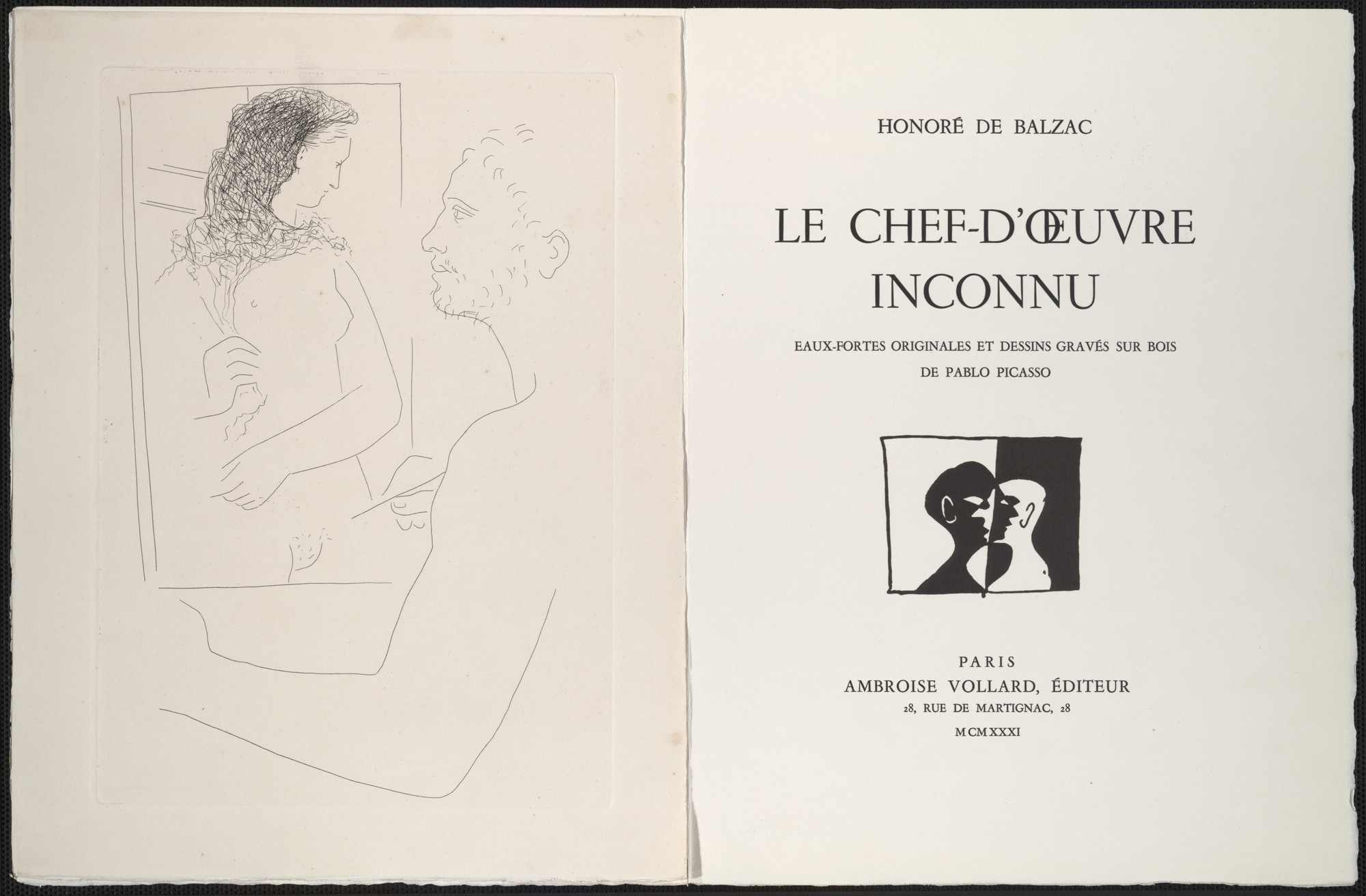
Achieving
perfect beauty, the absolute masterpiece: this is the dream that the painter
Frenhofer, the
hero of Honoré de Balzac's novel, Le Chef-d'oeuvre inconnu, pursued in
vain. Published for the first time in 1831, the text was illustrated a century
later by Pablo
Picasso, at the
request of art dealer Ambroise Vollard. The theme of the painter and his
model which
Picasso explores in his work represents the kind of ideal artistic vision which
leads to
Frenhorfer's death as he attempts to portray the expression of a soul, to reach
perfection
through a work of art.


The artist at
work is a running theme in Picasso's oeuvre. His many self-portraits, alone
or with a model,
are also reflections on the creative process. One of the most prolific
painters of the
20th century, relentlessly seeking new modes of expression, Picasso
dedicated his
life to a quest similar to that of Frenhofer. Through a selection of key
works,
milestones of Picasso's artistic career, the exhibition "Picasso: Masterpieces!"
looks back at
this journey.

From the conditions in which the artwork was produced to the influence of its critical reception, the exhibition examines the events that helped make each piece an icon of art. Throughout the 20th century, from the academic tradition to modern revolutions, Picasso's pursuits radically redefined the concept of the masterpiece.

From the conditions in which the artwork was produced to the influence of its critical reception, the exhibition examines the events that helped make each piece an icon of art. Throughout the 20th century, from the academic tradition to modern revolutions, Picasso's pursuits radically redefined the concept of the masterpiece.
2. SCIENCE ET
CHARITÉ


Science and Charité is one of the rare pieces from Picasso's youth which he kept for
himself, before
it was donated to the Museu Picasso in Barcelona in 1970. Thanks to the
close
relationship between this institution and the Musée national Picasso-Paris,
this work
is now being
exhibited in Paris for the first time.Picasso was only
16 when he painted Science et
Charité
While studying at Llotja, theSchool of Art and Design of Barcelona, he chose to paint a theme popular at art shows and among the followers of social realism: visiting the ill. The artist combines images from his daily life with academic models. His father acts as the model for the doctor, and
the subject
echoes a personal drama, the death of his younger sister Conchita in 1895.
Sent to the
General Exhibition of Fine Arts in Madrid, the work received an honourable
mention, before
it was awarded a gold medal at the Provincial Exhibition of Malaga. It
demonstrates the
incredible technical skill shown by the young Picasso.
3. LES
DEMOISELLES D'AVIGNON

When he discovered Les Demoiselles d'Avignon in 1907, Georges Braque said, "It is as
though, with
your painting, you wanted us to eat oakum or drink oil." From its creation
until its
exhibition at the Salon d'Antin in Paris in 1916, the work evoked reactions of
indifference,
incomprehension and rejection.
An emblematic canvas of the pictorial revolutions of the 20th century, Les Demoiselles d'Avignon was a foundational work in the bith of cubism. Jacques Doucet bought the piece in 1924 at the recommendation of poet André Breton, who was, at the time, one of the few able to recognize the significance of the acquisition.
However, when the designer died, the work returned to the art market. It joined the collection of the New York Museum of Modern Art in 1939. This institutional recognition conferred upon the painting the status of a modern masterpiece, more than thirty years after it was first created.
An emblematic canvas of the pictorial revolutions of the 20th century, Les Demoiselles d'Avignon was a foundational work in the bith of cubism. Jacques Doucet bought the piece in 1924 at the recommendation of poet André Breton, who was, at the time, one of the few able to recognize the significance of the acquisition.
However, when the designer died, the work returned to the art market. It joined the collection of the New York Museum of Modern Art in 1939. This institutional recognition conferred upon the painting the status of a modern masterpiece, more than thirty years after it was first created.
Les Demoiselles d'Avignon no longer
travels. The artist kept many studies for the painting
throughout his
life which today shed light on the genesis of the work. These studies have
become icons of the Musée national Picasso-Paris.
4. LES ARLEQUINS
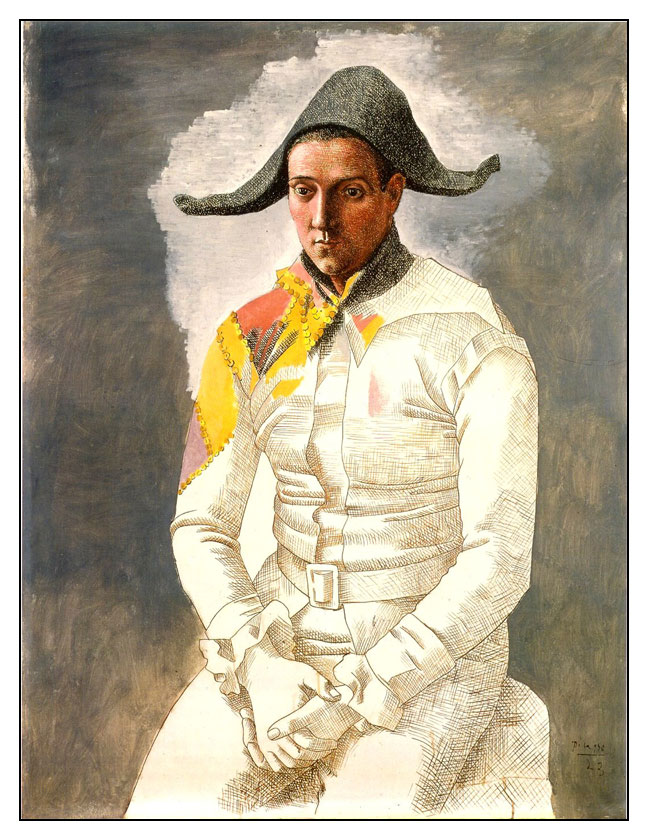

The Harlequin
figure, Picasso's nostalgic double, features throughout the
artist's works.
In 1923, amidst the Return to Order, it embodies the classic
ideal which
Picasso expresses in the genre of portraiture. The harlequin
theme,
particularly appreciated by the dealer Paul Rosenberg, quickly
gained favour in
the art world, even leading to a fund-raising campaign in
1967 to enable
the city of Basel to acquire Arlequin assis.

Arlequin assis (1923) Pablo Picasso. © Kunstmuseum Basel

Arlequin assis (1923) Pablo Picasso. © Kunstmuseum Basel
Picasso borrowed
characteristics from the Spanish painter Jacinto Salvadó
(1892-1983) for
these harlequins. From one piece to the next, the model
maintains the
same costume and his poses are imbued with the same
melancholy.
Picasso repeats and reworks these motifs throughout the series.
5. LES BAIGNEUSES

Pablo Picasso
On the Beach ( La baignade )
February 12, 1937
Oil, conté crayon, and chalk on canvas
50 13/16 x 76 3/8 inches (129.1 x 194 cm The Solomon R. Guggenheim Foundation, Peggy Guggenheim Collection, Venice, 1976
On 8 February
1937, Picasso's birthplace, Malaga, was seized by nationalist
troops. In the
space of just a few days - on the 10th, 12th and 18th of
February -
Picasso painted three troubling beach scenes featuring dominant,
imposing bathers.
He distorted their bodies and opted for a mineral palette.
The landscapes
are reduced to just a few lines. The viewer's gaze is focused
on these
monstrous figures, inspired by Picasso's conversations with
surrealists Man
Ray, Paul Éluard and Dora Maar, with whom he spent the
summers of 1936
and 1937.
Long kept in
private collections, these three works have rarely been
exhibited.
Representing a true series of masterpieces, they have been
brought together
for the first time in France for this exhibition, thanks to a
partnership
between the Peggy Guggenheim Foundation in Venice, the Lyon
Museum of Fine
Arts and the Musée national Picasso-Paris.
6. FEMMES À LEUR TOILETTE
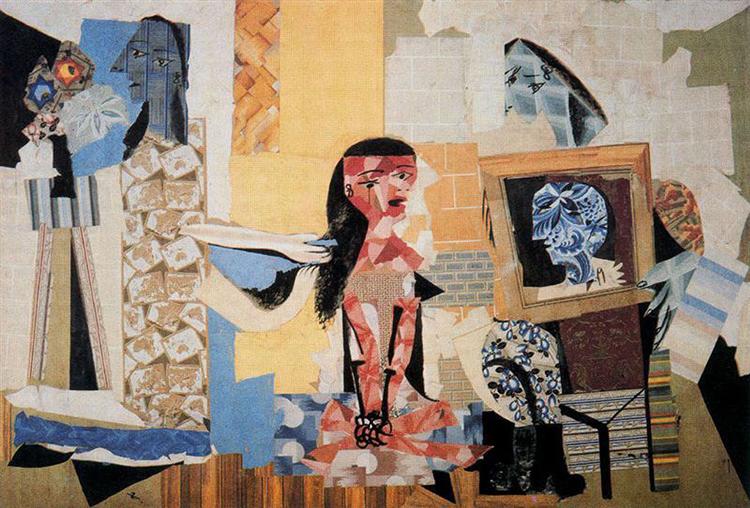
Femmes à leur toilette, a monumental collage created in the winter of 1937-1938,
is today
presented for the first time since its restoration in 2018.
Choosing the
traditional theme of hairstyling, Picasso stages three women
grooming
themselves, evoking a series of romantic partners with whom he had
been close. The
images of Olga Picasso, Marie-Thérèse Walter and Dora Maar
haunt the
composition of this tapestry cartoon, the only one designed by the
artist, which he
kept throughout his life. Completed at the Grands-Augustins
studio in Paris,
the work directly recalls Guernica, created a few
months earlier.
Picasso returns
to the concept of a very large format and assembles on the
canvas a
multitude of paper cuttings with varied motifs. The artist, who had
given up on the
idea of including elements of painted paper in Guernica at the
start of the
year, here gives free rein to this procedure inspired by the cubist
studies of
papier collé.
Femmes à leur toilette embodies the artistic revolutions that Picasso orchestrated throughout his life and is one of the masterpieces of the Musée national Picasso-Paris.
7. LA DANSE
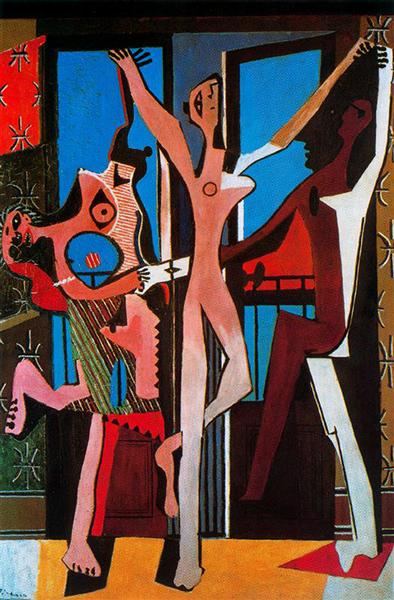

In spring 1925, Picasso and his wife Olga joined the Ballets russes in Monte
Carlo. Picasso's
interest in dance, never waning since his participation in the
ballet Parade in
1917, is shown here in a troubling round dance, and recalls the
death of his
friend, painter Ramon Pichot. Although each figure is represented
through its own
visual vocabulary, the influence of surrealism can be seen
through the
distortion of the bodies and in the composition, which evokes a
crucifixion, a
favourite theme of the group.


Exhibited in 1939, alongside Guernica, at the New York Museum of Modern Art,
La Danse remained
in Picasso's ownership for forty years; the artist refused to
part from it
despite keen interest from collectors. It was eventually acquired
by the Tate
Gallery in London in 1965, five years after the museum's major
retrospective
dedicated to the artist. This masterpiece of British collections
was presented at
the Grand Palais in 1966, in the exhibition "Hommage à
Pablo
Picasso", and is today on temporary loan from the Tate.
8. LE FAUCHEUR
In 1943, Picasso
chose the technique of assemblage to sculpt the original
plaster version
of Le Faucheur, whose face
is the imprint of a sand-cast mould.
Beyond this play
on everyday objects, André Malraux saw in
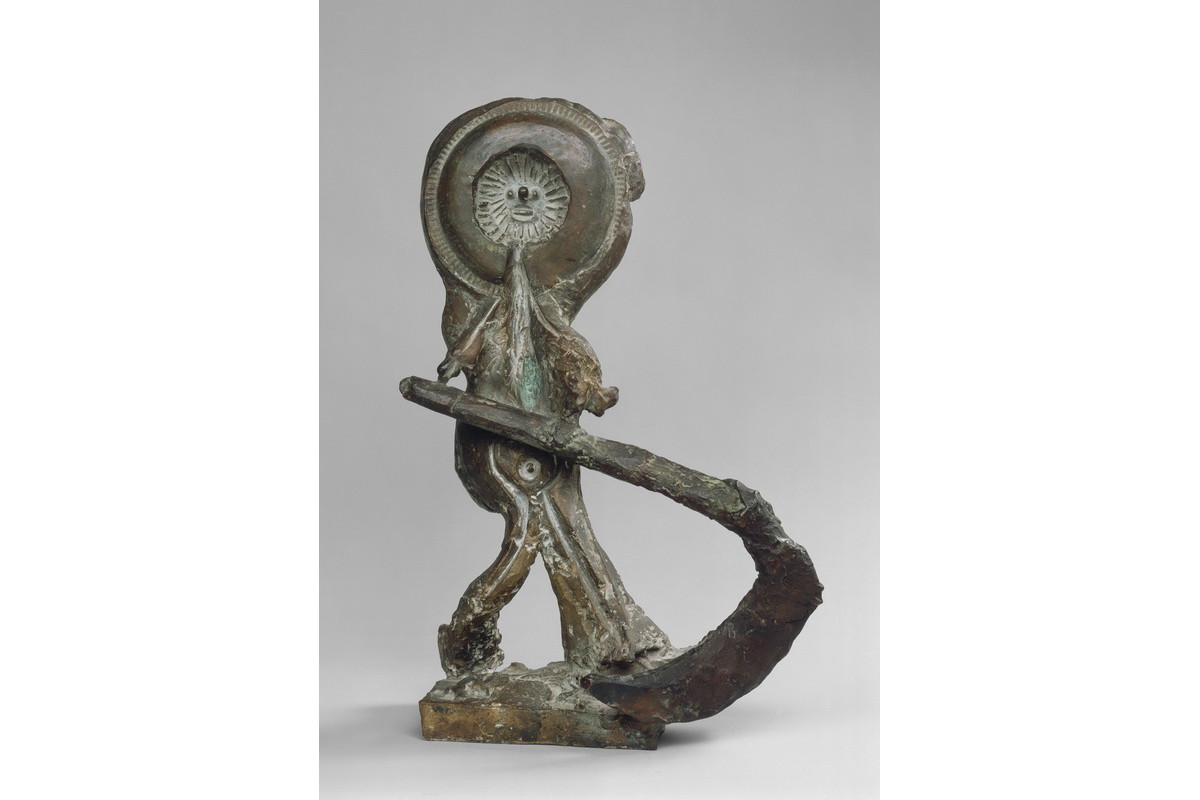
the bronze cast a true masterpiece, the very incarnation of the "act of death". On 19 November

the bronze cast a true masterpiece, the very incarnation of the "act of death". On 19 November
1966, at the
opening of the exhibition "Hommage à Pablo Picasso" at the
Grand and Petit
Palais, Picasso expressed the desire, never realised, to create
a huge,
monumental version of the work dedicated to Charles Baudelaire.
In 1968, under
Malraux's initiative, the law on the gifting of artworks as
payment of death
duties was established. Eleven years later, Le Faucheur
joined the
national collections after Picasso's heirs consented to gift it to the
state. It is
today exhibited in the very heart of the Hôtel Salé.
9. OBJETS
Paper cuttings,
iron wires and tablets... the pieces presented in this room
offer a new
perspective on Picasso's artistic process. With just a few
gestures, the
artist transforms everyday objects into artworks, combining
humour and
poetry. In the majestic Vénus du gaz , the artist
re-appropriates a
wood stove
burner by placing it vertically.
Most of these objects were kept by the surrealist photographer Dora Maar,
who shared her
life with Picasso from 1936. They were photographed by
Brassaï at
Picasso's request. Then, in 1949, the art dealer Daniel-Henry
Kahnweiler
included them in his work "Les Sculptures de Picasso." During
the public sale
of the Dora Maar collection in 1998, these objects attracted
huge attention,
Picasso's renown helping to forge their status as iconic
works which
re-examine the notion of the masterpiece under a new light.
10. JOSEP PALAU
I FABRE
« Mirar la
producción de Picasso, descubrir su obra, tiene que generar
siempre, una
euforia benefactora, porque él es, por encima de todo, vital »
(Josep Palau i
Fabre, Barcelone, 16 février 2003)
"Estimat Picasso" ("Dear Picasso"), this is the title of one publication by
Josep Palau i
Fabre (1917-2008), the Catalan poet and writer, who became
friends with the
artist in the 1960s. He dedicated more than twenty works
to Picasso and
gave him pride of place in his collection, today kept by the
Fundació Palau
in Caldes d’Estrac, in the province of Barcelona. Within this
collection, the
many dedications Picasso wrote to Palau i Fabre attests to the
close bond
between the artist and the biographer. Through his publications
and collection,
they writer offers a dual reading of Picasso's work, authoring
both literary and
scientific studies that portray the Spanish artist as a genius
of the 20th
century, and providing a glimpse of the private and everyday
creation of a
masterpiece, as exemplified by the marionette theater made by
Picasso for his
daughter Maya in 1942, exhibited in this room.
11. SCULPTURES
In Cannes,
Picasso enjoyed displaying his sculptures in the garden of the
villa La
Californie which he bought in 1955. Photographs by David Douglas
Duncan provide
an account of this installation which was only accessible to
visitors of the
studio. The sculptures are pretexts for much of his technical
experiments as
well as intimate works; as shown with Petit Cheval, created
from the legs of
table for the Spanish artist's grandson Bernard Ruiz-
Picasso.
It was only in
1966 that the general public was able to discover the full
wealth of
Picasso's sculpted work, during the exhibition "Hommage à Pablo
Picasso",
held at the Grand and Petit Palais, curated by Jean Leymarie.
196 sculptures
were presented, revealing an immense variety of subjects,
materials and
techniques. The event was extremely popular, and Picasso's
sculptures which
had once dwelled in the shadows of studios, finally
acquired the
public status of a masterpiece.
12. LA CHÈVRE
Between spring
2017 and spring 2019, the Musée national Picasso-Paris
is launching an
international cultural event bringing together over 60
institutions
within the framework "Picasso-Méditerranée". This collaboration
through the loan
of masterpiece has facilitated dialogue between the Musée
Picasso in
Antibes and the Picasso museum of Paris.
During the
summer of 1946, Picasso lived in Golfe-Juan, near Antibes.
Romuald Dor de
La Souchère invited him to set up his studio in the
Grimaldi museum,
where he was the director. The artist worked there from
September to
November and, upon his departure, left 23 paintings and 44
sketches to the
city. Twenty years later, Château Grimaldi became the first
museum dedicated
to Picasso in France, contributing to the artist's renown.


Of the works
produced in Antibes, La Chèvre is a
majestic representation of
an important animal
in Picasso's bestiary. As though incomplete, somewhere
between a sketch
and a painting, the animal's body combines realist drawing
and cubist
geometrization.
After the
creation of this unique masterpiece, the goat as a motif, inhabiting
the landscapes
of Bacchanalia and a symbol of the years in the south of
France, becomes
one of the emblems of Picasso's work.
13.
LITHOGRAPHIES
The
collaboration between Picasso and lithographer Fernand Mourlot began
in Paris in
1945, in a printing studio on Rue de Chabrol. Their conversations
led to the
creation of the famous
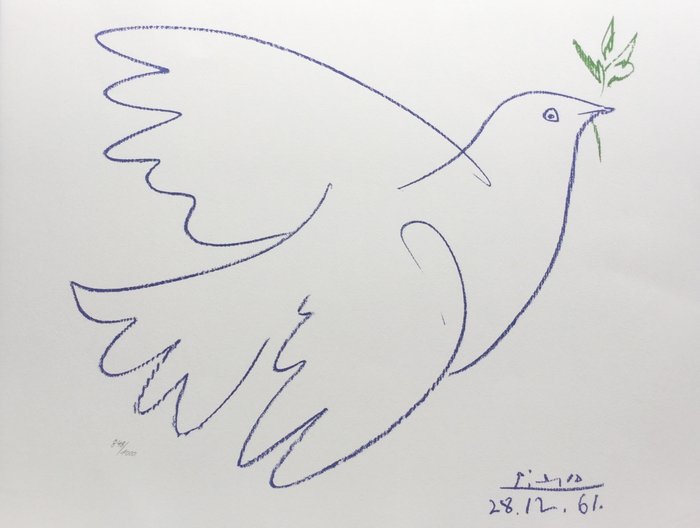
Colombe which, after being spotted by the poet Aragon in 1949,
became a symbol of peace printed in millions of copies found
across the entire world. In the printer's studio, the collaborations

Colombe which, after being spotted by the poet Aragon in 1949,
became a symbol of peace printed in millions of copies found
across the entire world. In the printer's studio, the collaborations
continued.
In 1948, Mourlot printed 215 of Picasso's plates for the book,
In 1948, Mourlot printed 215 of Picasso's plates for the book,
Le Chant des
morts by Pierre
Reverdy, a masterpiece of book illustration.
The two men
pushed the boundaries of lithography and embarked on an
unprecedented
exploration of poster art. The lithographic stones on which
the two men
worked as well as the tools and souvenirs of these experiments,
are today
exhibited for the first time.
In 1970, Fernand
Mourlot published the catalogue "Picasso
Lithographe."
The work reveals
the abundance of Picasso's research on prints and his
virtuosity in
the art of duplication; his printed images rank among his
masterpieces.
14. AVIGNON
From May to
October 1970, the Palais des Papes in Avignon dedicated a
first exhibition
to Picasso. Designed by the publisher Christian Zervos and
his wife Yvonne,
who died a few months before its opening, the project
inventoried the
artist's creations between the years 1969 and 1970. On 23
May 1973,
Jacqueline Roque opened a second exhibition at the Palais des
Papes,
"Picasso 1970-1972", one month after the artist's death. The works
exhibited
received virulent criticism; some were referred to as 'scribbles.'
In the 1980s,
however, new interpretations of Picasso's last paintings
emerged. As they
became compared to the works of such artists as Francis
Bacon and David
Hockney, art historians began to reassess their value.
15. EPILOGUE
For the writer
and art historian Pierre Daix, Rembrandt and Picasso are
united by an
"ancient intimacy." Traces of Rembrandt (1606-1669) are
found throughout
the Spanish artist's career, from his works on
Le Chef-d'oeuvre inconnu in the
1930s to the prints he focused on at the end of his
life. Beginning
in the 1960s, Picasso quoted Rembrandt in his musketeers
motif. Picasso's
dedication to engraving, which he pursued intensely in
his last studio,
was largely feuled by references to the great master of the
technique. For
Picasso, Rembrandt represented at once a guardian figure
and a rival from
a bygone century who epitomized a creative genius. His
reflections on
the self-portrait, a genre that Rembrandt explored throughout
his life and
which characterizes over 80 of his pieces, is a clear inspiration in
the last works
of the Spanish artist. In 1972, a few months before his death,
Picasso paid
tribute to the Dutch master in his ultimate masterpieces. Both
artists are brought together here, a
presage to the exhibition "Les Louvre de
Picasso"
at the Louvre-Lens in 2020.